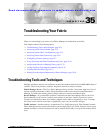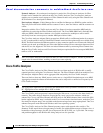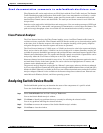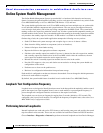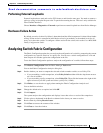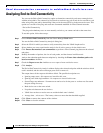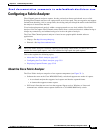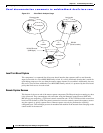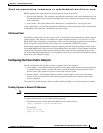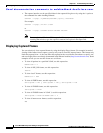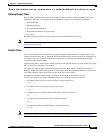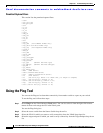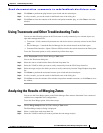
Send documentation comments to mdsfeedback-doc@cisco.com.
35-6
Cisco MDS 9000 Family Fabric Manager Configuration Guide
OL-6965-03, Cisco MDS SAN-OS Release 2.x
Chapter 35 Troubleshooting Your Fabric
Analyzing End-to-End Connectivity
Analyzing End-to-End Connectivity
You can use the End to End Connectivity option to determine connectivity and routes among devices
with the switch fabric. The connectivity tool checks to see that every pair of end devices can talk to each
other, using a Ping test and by determining if they are in the same VSAN or in the same active zone. This
option uses versions of the ping and traceroute commands modified for Fibre Channel networks.
- End to End Connectivity
The ping and redundancy tests are now mutually exclusive, you cannot run both at the same time.
To use this option, follow these steps:
Step 1 Choose End to End Connectivity from the Fabric Manager Tools menu.
You see the End to End Connectivity Analysis dialog box.
Step 2 Select the VSAN in which you want to verify connectivity from the VSAN dropdown list.
Step 3 Select whether you want to perform the analysis for all active zones or for the default zone.
Step 4 Click Ensure that members can communicate to perform a Fibre Channel ping between the selected
end points.
Step 5 Identify the number of packets, the size of each packet, and the timeout in milliseconds.
Step 6 Analyze the redundant paths between endpoints by checking the Ensure that redundant paths exist
between members checkbox.
Step 7 Check the Report errors for checkbox to see a report of zone and device errors.
Step 8 Click Analyze.
The End to End Connectivity Analysis window displays the selected end points with the switch to which
each is attached, and the source and target ports used to connect it.
The output shows all the requests which have failed. The possible descriptions are:
• Ignoring empty zone—No requests are issued for this zone.
• Ignoring zone with single member—No requests are issued for this zone.
• Source/Target are unknown—No nameserver entries exist for the ports or we have not discovered
the port during discovery.
• Both devices are on the same switch.
• No paths exist between the two devices.
• VSAN does not have an active zone set and the default zone is denied.
• Average time ... micro secs—The latency value was more than the threshold supplied.
Step 9 Click Clear to remove the contents of the window.
Step 10 Click Close to close the window.






